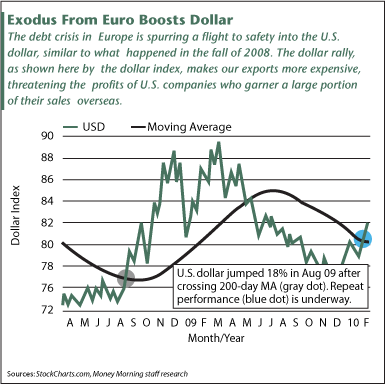When the stock market is enduring as much trouble as it has been lately, it pays to remember that there are still many positive catalysts that are in place and working to buoy securities prices.
Let's take a few moments to consider the top candidates:
- A Friendly Fed: The current U.S. Federal Reserve under Chairman Ben S. Bernanke is the most accommodative in history and is likely to keep short-term interest rates at or near zero for the remainder of this year. Occasionally there will be rumblings of an increase - as there was in The Wall Street Journal last Monday, but they are likely just smoke screens.
- Strong Capital Currents: Stimulus money and low interest rates continue to seep into the U.S. economic system. This capital is flowing much more slowly than expected, but the current will remain reasonably robust for another five years, as legislated last year. The government-provided stimulus package is largely responsible for the improvements in gross domestic product (GDP), factory-capacity utilization, retail spending and employment. The downside is that the longer the stimulus takes, the more it costs as interest fees stack up. One estimate suggests that for every $1 in stimulus, we're now getting only 20 cents of impact in the private economy.
- Contrarians Rule: Investors, the general public and the media are pretty morose about the market, and they are not flocking to move their money from certificates of deposit (CDs) and U.S. Treasury bills into stocks. The consensus is usually wrong, so this negative sentiment is a positive.
- A Strengthening Foundation: Economic fundamentals - the foundation of any recovery - are improving, as many more companies are reporting earnings growth than last quarter, and forward estimates are still being revised higher.
- Deflating the Bubble: Technically, the correction that has played out in recent weeks has taken froth off the market and created an "oversold" condition. And as I mentioned last Monday, stocks are now resting at a level that can be considered support.
In short, there are many reasons to expect stocks to advance. They really have a lot going for them.
However the big joke this year will come in the form of irony: While stocks rose last year despite lousy fundamentals, this year stocks will weaken despite improving fundamentals.
Why would that happen? Last year, investors were early to sniff out the gains that would be made in corporate fundamentals as the stimulus package and low interest rates worked their magic. Now investors are sniffing out the possibility that what you see is what you get - a subpar recovery plagued with subpar job growth and rising risk of sovereign debt failures.
Why should U.S. investors care about Europe's sovereign debt? It's actually pretty simple. Europe's burgeoning debt troubles are causing a mass exodus from the euro, and that money is going into U.S. dollars. As the dollar rises, our companies' exports become more expensive - and that inevitably has the effect of undermining the overseas profits of our multinational corporations.

In other words, if the dollar keeps rising, we'll discover that U.S. corporate earnings may well have peaked in the 2009 fourth quarter. Or we could find that they didn't actually peak, but will grow a lot more slowly, which is just as bad.
That's probably why the shares of major U.S.-based international companies such as The Coca-Cola Co. (NYSE: KO) and Colgate Palmolive Co. (NYSE: CL) have stalled lately. They're on a treadmill: No matter how much their business improves in the United States, it's being undermined and offset by the same amount overseas.
When you sum it all up, you can see that there are many positives (fundamentals, technicals, cheap money and fiscal stimulus) and one gigantic negative (a rising dollar). Since stock prices appear to be stuck, we have to conclude that the dollar is right now the biggest influence on share prices at present.
So until Europe gets its act together and regains investors' confidence, it looks like the dollar will keep rising and that, in turn, will keep pressuring American stocks.
One group that seems to have the fighting spirit is the U.S. small cap sector. They are battling with their downtrend from the mid-January highs, and appear to be trying to break higher.
Small-cap bulls must make a decisive move above the 595 level on the Russell 2000 or they will lose credibility. The bears know this, and will not yield this level easily. If the bulls are successful, the next stop for the Russell will be 615. They will probably fail, but it's nice to see some vigorous exertion, for once.
Checking a little deeper into the ranks of the Russell 2000, it appears that the upside effort is being carried primarily by small-cap regional banks such as New York Community Bancorp Inc. (NYSE: NYB), Whitney Holding Corp. (Nasdaq: WTNY), based in New Orleans, Susquehanna Bancshares Inc. (Nasdaq: SUSQ), based near Philadelphia. Maybe there's a World Series/ Super Bowl connection. All three are in definite short-term uptrends.
News and Related Story Links:
- Wall Street Journal:
Fed to Bare Tightening Plan - Money Morning News Category:
Jobless Recovery
- InvestorWords.com:
Oversold - Money Morning News Category:
Debt Bomb - Money Morning News Analysis:
As Greece's Woes Demonstrate, the Fuse Has Been Lit on the Global Debt Bomb - Money Morning News:
One Indicator That's Unquestionably Bullish


